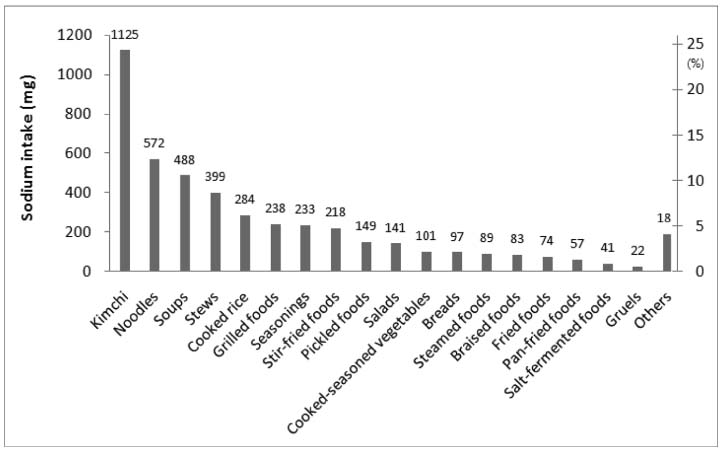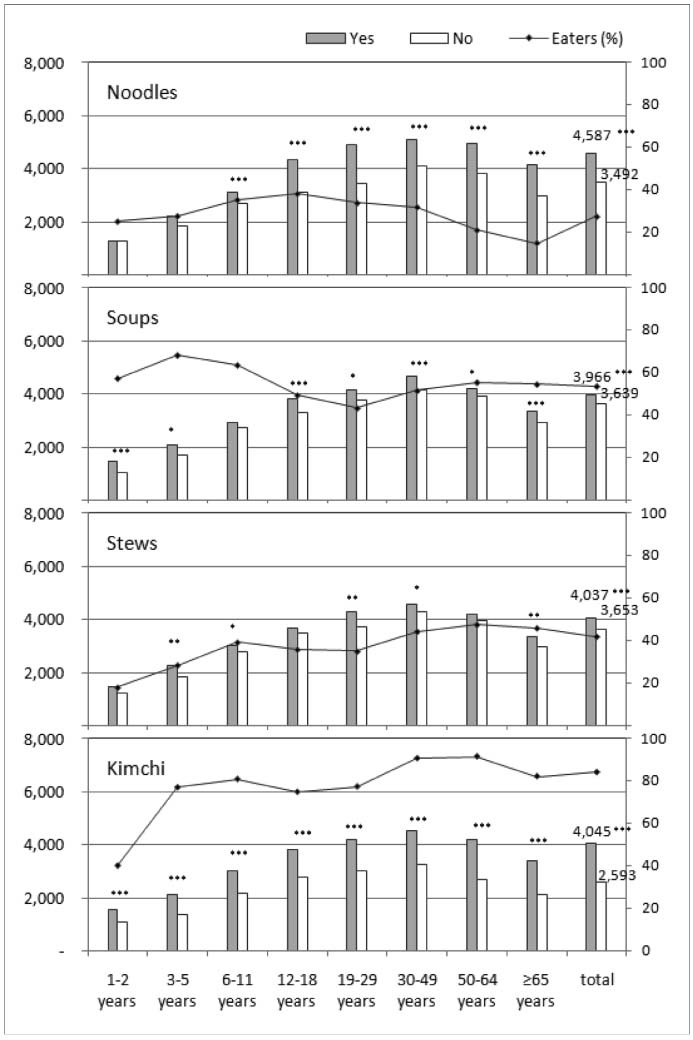Major Sources of Sodium Intake of the Korean Population at Prepared Dish Level: Based on the KNHANES 2008 & 2009
- Affiliations
-
- 1Nutrition Policy & Promotion Team, Korea Health Industry Development Institute, Chungbuk, Korea. kimci@khidi.or.kr
- 2Division of Nutrition Policy, Korea Food & Drug Administration, Chungbuk, Korea.
- KMID: 2266120
- DOI: http://doi.org/10.5720/kjcn.2011.16.4.473
Abstract
- We attempted to define the sources of sodium intake for the Korean population at prepared dish level to provide a basis for developing sustainable nutrition policies and feasible programs for sodium intake reduction. Dietary intake data from 2008 and 2009 Korea National Health and Nutrition Examination Survey was used in the analysis for sodium intake sources. Sodium intake from individual dish consumed by each subject was calculated and used in delineating major sodium sources at dish and dish group level for sub-populations of different sex and age. Also, sodium intake was compared between eaters and non-eaters of some specific dish groups with considerable contribution to total sodium intake. The number of subjects included in the analysis was 18,022 and mean sodium intake was 4,600 mg/capita/day. Major sources of sodium intake at dish group level were in the following order: kimchi (1125 mg, 24.5%), noodles (572 mg, 12.4%), soups (488 mg, 10.6%), stews (399 mg, 8.7%), and cooked rice (284 mg, 6.2%). The magnitude of contribution to total sodium intake by soups and stews was different by age group. Sodium intake difference between eaters and non-eaters was much larger for kimchi group (2,343 mg for male, 1,452 mg for female) than for soups or stews. Interaction between consumption of aforementioned specific dish groups and age was highly significant (p < 0.0005) for both sexes. This study revealed an importance of having not only the control over sodium content of foods/dishes, but also the customized approach for different groups of population to accomplish an appreciable reduction in sodium intake.
Keyword
Figure
Cited by 6 articles
-
Analysis of presumed sodium intake of office workers using 24-hour urine analysis and correlation matrix between variables
Hyun-Hee Kim, Yeon-Kyung Lee
Korean J Nutr. 2013;46(1):26-33. doi: 10.4163/kjn.2013.46.1.26.Trends in the major dish groups and food groups contributing to sodium intake in the Korea National Health and Nutrition Examination Survey 1998-2010
Da Young Song, Jong Eun Park, Jae Eun Shim, Jung Eun Lee
Korean J Nutr. 2013;46(1):72-85. doi: 10.4163/kjn.2013.46.1.72.Dietary quality differs by consumption of meals prepared at home vs. outside in Korean adults
Kyung Won Lee, Won O. Song, Mi Sook Cho
Nutr Res Pract. 2016;10(3):294-304. doi: 10.4162/nrp.2016.10.3.294.Salt content of school meals and comparison of perception related to sodium intake in elementary, middle, and high schools
Sohyun Ahn, Seoyun Park, Jin Nam Kim, Sung Nim Han, Soo Bin Jeong, Hye-Kyeong Kim
Nutr Res Pract. 2013;7(1):59-65. doi: 10.4162/nrp.2013.7.1.59.Comparison of sodium content of workplace and homemade meals through chemical analysis and salinity measurements
Eun-Kyung Shin, Yeon-Kyung Lee
Nutr Res Pract. 2014;8(5):558-563. doi: 10.4162/nrp.2014.8.5.558.Salt Intake and Diabetes
Jeong Hyun Lim
J Korean Diabetes. 2012;13(4):211-214. doi: 10.4093/jkd.2012.13.4.211.
Reference
-
1. Alderman MH, Cohen H, Madhavan S. Dietary sodium intake and mortality: The National Health and Nutrition Examination Survey (NHANES I). Lancet. 1998. 351(9105):781–785.2. Blaustein MP, Hamlyn JM. Pathogenesis of essential hypertension. A link between dietary salt and high blood pressure. Hypertension. 1991. 18:5 Suppl. III184–III195.3. Brown IJ, Tzoulaki I, Candeias V, Elliott P. Salt intakes around the world: implications for public health. Int J Epidemiol. 2009. 38(3):791–813.4. Cho HS, Ahn MS. A survey on the consumption patterns of ramyon by high school students in a part Chun-nam area. J Living Cult Res. 1993. 7(1):43–55.5. Chobanian AV, Hill M. National Heart, Lung, and Blood Institute Workshop on Sodium and Blood Pressure: a critical review of current scientific evidence. Hypertension. 2000. 35(4):858–863.6. Cohen HW, Hailpern SM, Alderman MH. Sodium intake and mortality follow-up in the third National Health and Nutrition Examination Survey (NHANES III). J Gen Intern Med. 2008. 23(9):1297–1302.7. Craddick SR, Elmer PJ, Obarzanek E, Vollmer WM, Svetkey LP, Swain MC. The DASH diet and blood pressure. Curr Atheroscler Rep. 2003. 5:484–491.8. Elliott P, Stamler J, Nichols R, Dyer AR, Stamler R, Kesteloot H, Marmot M. Intersalt Cooperative Research Group. Intersalt revisited: further analyses of 24 hour sodium excretion and blood pressure within and across populations. BMJ. 1996. 312(7041):1249–1253.9. He J, Oqden LG, Vupputuri S, Bazzano LA, Loria C, Whelton PK. Dietary sodium intake and subsequent risk of cardiovascular disease in overweight adults. JAMA. 1999. 282(21):2027–2034.10. Hyun YH, Kim MH, Jang MS. Consumption patterns of ramyon by high school students. Korean J Soc Food Sci. 1990. 6(1):61–66.11. Intersalt Cooperative Research Group. Intersalt: an international study of electrolyte excretion and blood pressure. Results for 24 hour urinary sodium and potassium excretion. BMJ. 1988. 297(6644):319–328.12. Jang MS, Hwang JH, Huun YH. Consumption pattern of ramyon by elementary school pupils. Korean J Soc Food Sci. 1988. 4(2):81–86.13. Kim SH, Abbasi F, Lamendola C, Reaven GM. Effect of moderate alcoholic beverage consumption on insulin sensitivity in insulin-resistant, nondiabetic individuals. Metabolism. 2009. 58(3):387–392.14. Lee JS, Kim JS, Hong KH, Jang YA, Park SH, Sohn YA, Chung HR. A comparison of food and nutrient intakes between instant noodle consumers and non-consumers among Korean children and adolescents. Korean J Nutr. 2009. 42(8):723–731.15. Lee JW, Lee YH. Frequency of instant noodle(Ramyeon) intake and food value recognition and their relationship to blood lipid levels of male adolescents in rural area. Korean J Community Nutr. 2003. 8(4):485–494.16. Lee JY, Mok CK. Changes in physicochemical properties of low salt soybean paste(Doenjang) during fermentation. Food Eng Prog. 2010. 14(2):153–158.17. Lee KW, Lee HS, Lee MJ. A study on the eating behaviors of self-purchasing snack among elementary school students. Korean J Food Cult. 2005. 20(5):594–602.18. Ministry of Health and Welfare, Korea Centers for Disease Control & Prevention. National Health Statistics - The 4th Korea National Health & Nutrition Examination Survey (KNHANES IV) 2009. 2010.19. Ministry of Health and Welfare, Korea Centers for Disease Control & Prevention. National Health Statistics - The 4th Korea National Health & Nutrition Examination Survey (KNHANES IV) 2008. 2009.20. Ministry of Health and Welfare, Korea Health Industry Development Institute. Database Development for Nutrient Composition of Foods. 2000.21. Ministry of Health and Welfare, Korea Health Industry Development Institute. The Third Korea National Health & Nutrition Examination Survey (KNHANES III), 2005 - Nutrition Survey(I, II). 2006.22. Mok CK, Song KT, Lee JY, Park YS, Lim SB. Changes in microorganisms and enzyme activity of low salt soybean paste (Doenjang) during fermentation. Food Engineering Progress. 2005. 14(2):153–158.23. Moon HK, Choi SO, Kim JE. Analysis of nutrition education about sodium intakes for the elderly living in the rural area. Korean J Community Nutr. 2009. 14(1):123–136.24. Paik HY. Effect of salt intake and other dietary factors on development and treatment of hypertension in Korea. 2004. Ministry of Health & welfare.25. Park SH, Lee JS, Hong H. The food and nutrient intakes on weekdays and weekends among high school girls in Seoul. Korean J Nutr. 2010. 43(5):513–523.26. Park YW, Zhu S, Palaniappan L, Heshka S, Carnethon MR, Heymsfield SB. The metabolic syndrome: prevalence and associated risk factor findings in the US population from the third National Health and Nutrition Examination Survey, 1988-1994. Arch Intern Med. 2003. 163(4):427–436.27. Rhee M-Y, Yang SJ, Oh SW, Park Y, Kim C-i, Park H-K, Park SW, Park C-Y. Novel genetic variations associated with salt sensitivity in the Korean population. Hypertension Research. 2011. 34:606–611.28. SAS Publishing. SAS/Stat 9.2 User Guide/Survey data analysis. Chapter 2. 2009. 13–24.29. Son SM. Pilot study for low salt consumption projects for Korean people. 2009. Ministry of Health & Welfare.30. Son SM, Park YS, Lim HJ, Kim SB, Jeong YS. Sodium intakes of Korean adults with 24-hour urine analysis and dish frequency questionnaire and comparison of sodium intakes according to the regional area and dish group. Korean J Community Nutr. 2007. 12(5):545–558.31. Stamler R. Implications of the intersalt study. Hypertension. 1991. 17:1 Suppl. I16–I20.32. Stamler J. The INTERSALT Study: background, methods, findings, and implications. Am J Clin Nutr. 1997. 65:2 Suppl. 626S–642S.33. Sung SH, Yu OK, Sohn HS, Cha YS. A comparison of dietary behaviors according to gender and obesity status of middle school students in Jeonju. J Korean Soc Food Sci Nutr. 2007. 36(8):995–1009.34. The Korean Nutrition Society. Dietary reference intakes for Koreans. 2010.35. Tsugane S. Salt, salted food intake, and risk of gastric cancer: epidemiologic evidence. Cancer Sci. 2005. 96(1):1–6.36. U.S. Department of Agriculture. Nutrient Intakes from Foods What We Eat in America, NHANES, 2007-2008. Agricultural Research Service. 2010. 2010. Available from http://www.ars.usda.gov/ba/bhnre/fsrg.37. Xie JX, Sasaki S, Joossens JV, Kesteloot H. The relationship between urinary cations obtained from the INTERSALT study and cerebrovascular mortality. J Hum Hypertens. 1992. 6(1):17–21.38. Yang Q, Liu T, Kuklina EV, Flanders WD, Hong Y, Gillespie C, Chang MH, Gwinn M, Dowling N, Khoury MJ, Hu FB. Sodium and potassium intake and mortality among US adults: Prospective data from the third National Health and Nutrition Examination Survey. Arch Intern Med. 2011. 171(13):1183–1191.39. Yon MY, Lee MS, Oh SI, Park SC, Kwak CS. Assessment of food consumption, dietary diversity and dietary pattern during the summer in middle aged adults and older adults living in Gugoksoondam longevity area, Korea. Korean J Community Nutr. 2010. 15(4):536–549.
- Full Text Links
- Actions
-
Cited
- CITED
-
- Close
- Share
- Similar articles
-
- Trends in the major dish groups and food groups contributing to sodium intake in the Korea National Health and Nutrition Examination Survey 1998-2010
- A Comparison of Sources of Sodium and Potassium Intake by Gender, Age and Regions in Koreans: Korea National Health and Nutrition Examination Survey (KNHANES) 2010-2012
- Trends in sodium intake and major contributing food groups and dishes in Korea: the Korea National Health and Nutrition Examination Survey 2013–2017
- A study of the major dish group, food group and meal contributing to sodium and nutrient intake in Jeju elementary and middle school students
- Developing Dish-based Food Frequency Questionnaire for the Epidemiology Study of Hypertension Among Korean





